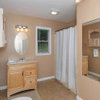Durock - Hardi - Wonderboard - Kerdi
mowers
14 years ago
Confused. So many options. I was set with a contractor to have a bathtub done using Durock with a poly membrane underneath. Then I did some internet reading and found too much information. Is one system better than the other? I read Kerdi is good, but expensive. Expensive is a turn off being the conventional ways have been working fine for years. Is Kerdi necessary? Is Hardi board better than Wonderboard or Durock?


studio460
mowersOriginal Author
Related Professionals
East Islip Kitchen & Bathroom Designers · La Verne Kitchen & Bathroom Designers · Waianae Kitchen & Bathroom Designers · Biloxi Kitchen & Bathroom Remodelers · Emeryville Kitchen & Bathroom Remodelers · Hunters Creek Kitchen & Bathroom Remodelers · Port Angeles Kitchen & Bathroom Remodelers · Richland Kitchen & Bathroom Remodelers · Roselle Kitchen & Bathroom Remodelers · Salt Lake City Glass & Shower Door Dealers · Livingston Cabinets & Cabinetry · Newcastle Cabinets & Cabinetry · White Center Cabinets & Cabinetry · Wildomar Cabinets & Cabinetry · Dallas Window TreatmentsMongoCT
studio460
studio460
MongoCT
studio460
MongoCT
Avanti Tile & Stone / Stonetech
leaf29